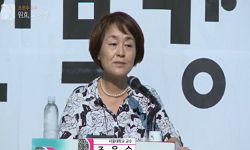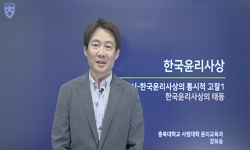본질-작용(體用, Ch. ti-yong, J. tai-yū; 일본에서 불교학 이외의 연구에서는 tai-yō) 패러다임은 기원전 5세기부터 근대 시기에 이르기까지 중국, 한국, 일본의 종교・철학적 문헌을 해석할 때에 �...
http://chineseinput.net/에서 pinyin(병음)방식으로 중국어를 변환할 수 있습니다.
변환된 중국어를 복사하여 사용하시면 됩니다.
- 中文 을 입력하시려면 zhongwen을 입력하시고 space를누르시면됩니다.
- 北京 을 입력하시려면 beijing을 입력하시고 space를 누르시면 됩니다.

The Emergence of Essence-Function (ti-yong) 體用 Hermeneutics in the Sinification of Indic Buddhism : An Overview
한글로보기https://www.riss.kr/link?id=A101941376
-
저자
A. Charles Muller (University of Tokyo)

- 발행기관
- 학술지명
- 권호사항
-
발행연도
2016
-
작성언어
English
-
주제어
본질-작용(體用) ; 이사(理事) ; 이기(理氣) ; <대승기신론> ; 중국불교 ; 원효 ; 지눌 ; essence-function(ti-yong 體用) ; li-shi(理事) ; li-qi(理氣) ; the Awakening of Mahāyāna Faith(大乘起信論) ; Chinese Buddhism ; Wonhyo ; Jinul
-
등재정보
KCI등재후보
-
자료형태
학술저널
-
수록면
111-152(42쪽)
-
KCI 피인용횟수
4
-
비고
학회 요청에 의해 무료로 제공
- 제공처
-
0
상세조회 -
0
다운로드
부가정보
국문 초록 (Abstract)
본질-작용(體用, Ch. ti-yong, J. tai-yū; 일본에서 불교학 이외의 연구에서는 tai-yō) 패러다임은 기원전 5세기부터 근대 시기에 이르기까지 중국, 한국, 일본의 종교・철학적 문헌을 해석할 때에 가장 널리 사용된 해석학적 틀로 볼 수 있다. 먼저 중국에서는 유교, 도교, 불교에 적용되는 과정에서 풍부한 발전을 이루었는데, 특히 인도 불교의 중국화 과정에서 폭넓게 적용되었다. 그리고 종종 理事(li-shi)와 유사한 형태로 화엄, 천태, 선과 같은 중국 토착 불교 학파들의 철학을 위한 토대를 형성하였다. 나아가 송대 신유학(新儒學)에서 ‘체용’ 의 용례는 특히 잇따라 나타나는 또 다른 유사형태인 理氣(li-qi)의 형식으로 변화하고 확장되었다. 불교와 신유학 모두 한국에 뿌리를 내리면서 한국 학자들은 신유교와 불교 각각의 종교에 대한 해석뿐 아니라, 둘 사이에 있었던 대화와 논쟁에도 체용 패러다임을 폭넓게 적용하였다. 본 논문은 동양과 서양 모두의 불교학에서 거의 완전히 무시되었던 이 지극히 중요한 철학적 패러다임에 관한 논의를 되살려 보고자 한다. 그리고 이것을 중국 불교 주석문헌들 초기의 용례, <대승기신론>속에 나타난 그 역할, 더불어 한국 불교, 특히 원효와 지눌의 저작에서 사용된 몇 가지 용례들을 조사함으로써 시도할 것이다.
다국어 초록 (Multilingual Abstract)
The essence-function 體用 (Ch. ti-yong, K. che-yong, J. tai-yū; in non-Buddhological studies in Japan, tai-yō) paradigm can be seen as the most pervasively-used hermeneutical framework in the interpretation of Chinese, Korean, and Japanese religio...
The essence-function 體用 (Ch. ti-yong, K. che-yong, J. tai-yū; in non-Buddhological studies in Japan, tai-yō) paradigm can be seen as the most pervasively-used hermeneutical framework in the interpretation of Chinese, Korean, and Japanese religious and philosophical works ranging from as early as the 5th century BCE up to premodern times. It developed in richness during the course of its application in Confucianism, Daoism, and Buddhism, first in China, where it was applied extensively in the sinification of Indian Buddhist doctrine, and formed the basic framework for the philosophy of the Chinese indigenous schools of Buddhism such as Huayan, Tiantai, and Chan, often in analogous forms such as li-shi 理事. It was then further transformed and expanded in its usage in Song Neo-Confucianism, especially in the form yet another analogue li-qi 理氣. As both Buddhism and Neo-Confucianism took root in Korea, Korean scholars made extensive use of the che-yong paradigm, both in the interpretation of the individual religions of Confucianism and Buddhism, as well as in interreligious dialog and debate. This paper seeks to revive discussion of this vitally important philosophical paradigm, which has been almost fully ignored in Buddhological studies, both East and West, by examining its early appearances in Chinese Buddhist commentary, and then its role in the Awakening of Mahāyāna Faith, as well as some examples of its usage in Korean Buddhism, in the writings of Wonhyo and Jinul.
목차 (Table of Contents)
- 국문요약
- I. Essence-function 體用: Introduction
- II. Defining Essence-function 體用
- III. Essence-function 體用: Problems with English Translation
- IV. Essence-function 體用: Appearance in Early Chinese Buddhism
- 국문요약
- I. Essence-function 體用: Introduction
- II. Defining Essence-function 體用
- III. Essence-function 體用: Problems with English Translation
- IV. Essence-function 體用: Appearance in Early Chinese Buddhism
- V. Jizang
- VI. Essence-function 體用: The Awakening of Mahāyāna Faith
- VII. Essence-function 體用: Some More Examples
- VIII. Korea
- 1. Wonhyo
- 2. Seon, Jinul, and the Pervasive Frame of Essence-Function
- IX. Neo-Confucian Expansion of the Essence-Function Paradigm
- X. Conclusion
- 참고문헌
- Abstract
참고문헌 (Reference)
1 Shimada, Kenji, "Tsukamoto Hakase hanju kinen bukkyōshi ronshū(塚本博士頒壽記念佛教史學論集)" 416-432, 1991
2 Muller, A. Charles, "Tiyong and Interpenetration in the Analects of Confucius: The Sacred as Secular" 8 : 93-106, 2000
3 Chung, Edward Y. J., "The Korean Neo-Confucianism of Yi T'oegye and Yi Yulgok: A Reappraisal of the “Four-Seven Thesis” and Its Practical Implications for Self-Cultivation" State University of New York Press 1995
4 Muller, A. Charles, "The Key Operative Concepts in Korean Buddhist Syncretic Philosophy:Interpenetration and Essence-Function in Wŏnhyo, Chinul and Kihwa" 3 : 33-48, 1995
5 Kalton, Michael, "The Four-Seven Debate: An Annotated Translation" SUNY Press 1994
6 Muller, A. Charles, "The Composition of Self-Transformation Thought in Classical East Asian Philosophy and Religion" 4 : 141-152, 1996
7 Lynn, Richard John, "The Classic of the Way and Virtue: A New Translation of the Tao-Te Ching of Laozi as Interpreted by Wang Bi. The classic of the way and virtue" Columbia University Press 1999
8 Lai, Whalen, "The Awakening of Faith in Mahayana (Ta-ch'eng ch’i-hsin lun): A Study of the Unfolding of Sinitic Mahayana Motifs" Harvard University 1975
9 Funayama, Tōru, "Tai-yū shōkō 體用小考. In Rokuchō Zuitō seishinshi no kenkyū 六朝隨唐精神史" JSPS 125-136, 2004
10 Shimada, Kenji, "Shushigaku to Yōmeigaku(朱子学と陽明学)" Iwanami shoten 1967
1 Shimada, Kenji, "Tsukamoto Hakase hanju kinen bukkyōshi ronshū(塚本博士頒壽記念佛教史學論集)" 416-432, 1991
2 Muller, A. Charles, "Tiyong and Interpenetration in the Analects of Confucius: The Sacred as Secular" 8 : 93-106, 2000
3 Chung, Edward Y. J., "The Korean Neo-Confucianism of Yi T'oegye and Yi Yulgok: A Reappraisal of the “Four-Seven Thesis” and Its Practical Implications for Self-Cultivation" State University of New York Press 1995
4 Muller, A. Charles, "The Key Operative Concepts in Korean Buddhist Syncretic Philosophy:Interpenetration and Essence-Function in Wŏnhyo, Chinul and Kihwa" 3 : 33-48, 1995
5 Kalton, Michael, "The Four-Seven Debate: An Annotated Translation" SUNY Press 1994
6 Muller, A. Charles, "The Composition of Self-Transformation Thought in Classical East Asian Philosophy and Religion" 4 : 141-152, 1996
7 Lynn, Richard John, "The Classic of the Way and Virtue: A New Translation of the Tao-Te Ching of Laozi as Interpreted by Wang Bi. The classic of the way and virtue" Columbia University Press 1999
8 Lai, Whalen, "The Awakening of Faith in Mahayana (Ta-ch'eng ch’i-hsin lun): A Study of the Unfolding of Sinitic Mahayana Motifs" Harvard University 1975
9 Funayama, Tōru, "Tai-yū shōkō 體用小考. In Rokuchō Zuitō seishinshi no kenkyū 六朝隨唐精神史" JSPS 125-136, 2004
10 Shimada, Kenji, "Shushigaku to Yōmeigaku(朱子学と陽明学)" Iwanami shoten 1967
11 Park, Sung Bae, "One Koreanʼs Approach to Buddhism: The Mom/Momjit Paradigm" SUNY Press 2009
12 Cheng, Chung-Ying, "On The Metaphysical Significance Of Ti (Body-Embodiment) In Chinese Philosophy: Benti (Origin-Substance)And Ti-Yong (Substance And Function)" 29 (29): 145-161, 2002
13 Cua, Antonio S., "On The Ethical Significance of the Ti-Yong Distinction" 29 (29): 163-170, 2002
14 Kong, Roberta Lion, "Metaphysics and East-West Philosophy: Applying the Chinese T’i-yung Paradigm" 29 (29): 49-58, 1979
15 Muller, A. Charles, "Korea’s Great Buddhist-Confucian Debate: The Treatises of Chŏng Tojŏn (Sambong) and Hamhŏ Tŭkt’ong (Kihwa)" University of Hawai`i Press 2015
16 Gedalecia, David, "Excursion in Substance and Function: The Development of the T’i-Yung Paradigm in Chu Hsi" 24 (24): 443-451, 1974
17 Lai, Whalen W., "Ch’an Metaphors: Waves, Water, Mirror, Lamp" 29 : 243-253, 1983
18 Hirai, Shun’ei, "Chugoku bukkyō to taiyū shisō 中国仏教と体用思想" 549 : 60-72, 1979
19 Buswell, Robert E. Jr, "Chinul 知訥: Selected Works, Collected Works of Korean Buddhism" Jogye Order of Korean Buddhism 2012
20 Park, Sung Bae, "Buddhist Faith and Sudden Enlightenment" SUNY Press 1983
동일학술지(권/호) 다른 논문
-
청변의 베다 비판과 미맘사학파에 대항한 불교-상캬 연합
- 금강대학교 불교문화연구소
- 함형석
- 2016
- KCI등재후보
-
푸드갈라 존재 양태의 다양성에 관하여 ― 중후기 중관 문헌들을 중심으로 -
- 금강대학교 불교문화연구소
- 정상교
- 2016
- KCI등재후보
-
吉藏と元曉における四句解釋 ― 中觀思想の東アジア的展開という観点から ー
- 금강대학교 불교문화연구소
- 中西俊英
- 2016
- KCI등재후보
-
열반은 지각이 없는 상태와 동일한가? 중국, 인도 불교관과 투쟁하다
- 금강대학교 불교문화연구소
- 로버트 샤프
- 2016
- KCI등재후보
분석정보
인용정보 인용지수 설명보기
학술지 이력
| 연월일 | 이력구분 | 이력상세 | 등재구분 |
|---|---|---|---|
| 2026 | 평가예정 | 재인증평가 신청대상 (재인증) | |
| 2020-01-01 | 평가 | 등재학술지 유지 (재인증) |  |
| 2017-01-01 | 평가 | 등재학술지 선정 (계속평가) |  |
| 2015-01-01 | 평가 | 등재후보학술지 선정 (신규평가) |  |
학술지 인용정보
| 기준연도 | WOS-KCI 통합IF(2년) | KCIF(2년) | KCIF(3년) |
|---|---|---|---|
| 2016 | 0.64 | 0.64 | 0.45 |
| KCIF(4년) | KCIF(5년) | 중심성지수(3년) | 즉시성지수 |
| 0.54 | 0.46 | 0.971 | 0.33 |




 eArticle
eArticle




